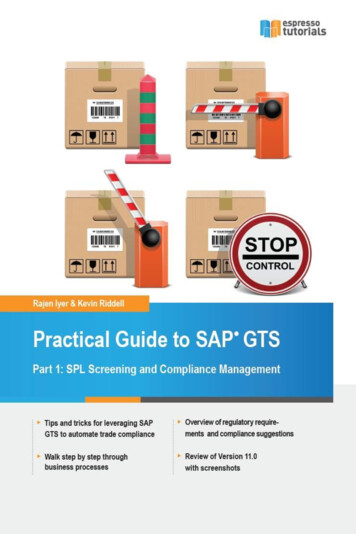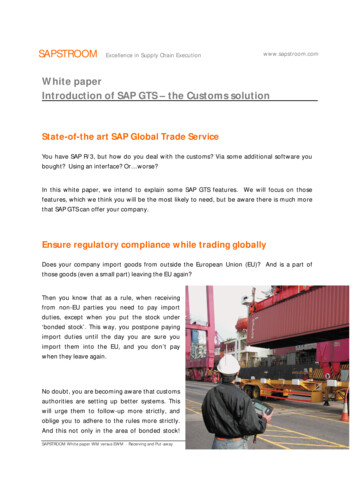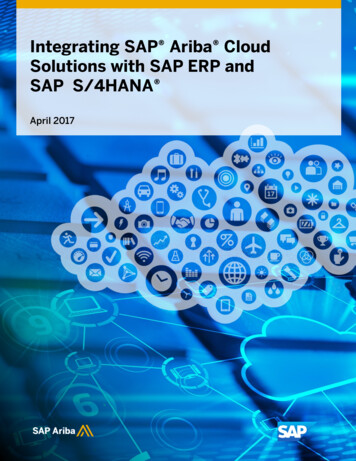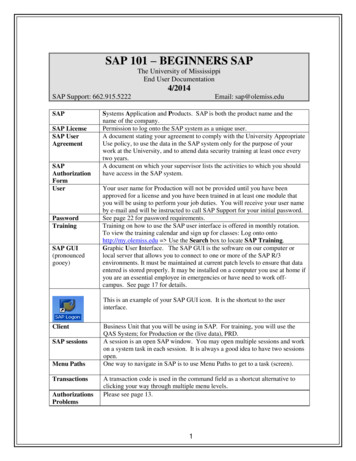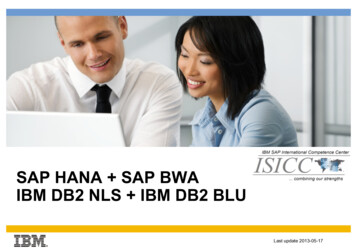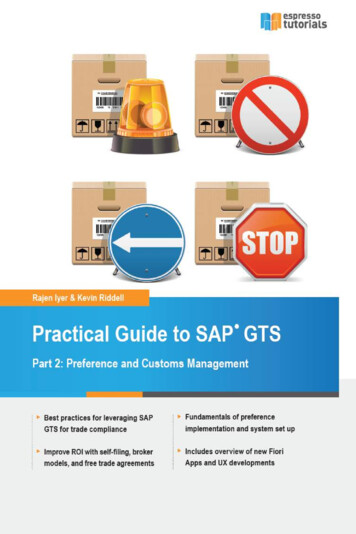
Transcription
Practical Guide toSAP GTSPart 2:Preference andCustoms ManagementKevin RiddellRajen Iyer
Table of ContentsPreface7Introduction91 Risk Management/Preference processing131.1Preference processing user guide141.2Preference processing—master data761.3Preference compliance tips801.4Preference processing configuration972 Customs management1252.1Customs declarations overview1282.2SAP ECC configuration1322.3General settings configuration for SAP GTS1362.4SAP GTS customs management configuration1472.5AES in SAP GTS1592.6ATLAS1822.7SAP GTS setup for import/export self-filing1842.8User guide1952.9Compliance tips2243 SAP GTS Release 11.02413.1General configuration settings2413.2In-memory optimization2473.3SPL with HANA Search2483.4Enhanced user experience2523.5FTZ2533.6Customs management improvements2555
TABLE OF CONTENTS3.7Improvements to compliance management2583.8Preference improvements2614 Version 11 Screen Personas and SAP Fiori2634.1Setup/configuration2634.2Screen Personas2694.3Mobile apps with SAP Fiori2715 Appendix 1: Discovery questions for automatedpreference justification5.1275Suggested data to gather and discovery phase questions 2756 Appendix 2: Sample ROI calculator2796.1ROI calculator explanation2796.2FTA Zone ROI calculator tool2816.3Example of a completed ROI calculator2827 Appendix 3: Website resources2837.1Sanctioned party list resources2837.2Preferential trade resources2847.3Export/import control resources2857.4Customs compliance resources286A About the Authors288B Index290C Disclaimer2946
2 Customs managementCompanies need to have a process to manage importing goods intotheir country and the declarations that go along with importing. Toimprove efficiency, reduce costs in your compliance process, andavoid delays in customs clearance, you can automate your importdeclarations using functionality in SAP GTS.Depending on the country, there may be multiple declarations required.For example, US Customs and Border Protection (CBP) has a rule as ofJanuary 26, 2009 called Importer Security Filing (ISF) and AdditionalCarrier Requirement. Under this rule, before any goods arrive by vesselinto the US, the Importer Security Filing (ISF) needs to be submittedelectronically, in advance, by the importer or the agent (licensed customsbroker) to the CBP. This requirement only applies to cargo arriving in theUS by ocean vessel, not to other modes of transportation. The ISF importer or its agent must provide eight data elements no later than 24hours before the cargo is loaded on a vessel destined to the US. Thisdeclaration is required in addition to the standard customs import declaration, which applies to all modes.ISF data elements are seller, buyer, importer of record number, consignee number, manufacturer (or supplier), ship-to party, country of origin,and the commodity’s Harmonized Tariff Schedule of the United States(HTSUS) number. Two additional data elements—container stuffing location and consolidator—must be submitted as early as possible and nolater than 24 hours prior to the ship’s arrival at a US port.CBP may issue liquidation of 5,000 per violation for the submission ofan inaccurate, incomplete, or untimely filing. If goods for which an ISFhas not been filed arrive in the US, the CBP can withhold the release ortransfer of the cargo, refuse the unloading of the merchandise, or seize itif it is illegally unloaded. Additional noncompliant cargo could be subjectto “do not load” orders at origin or further inspection on arrival.From an import point of view, companies use different approaches tomeet these requirements. We will discuss the import processes setupusing SAP ERP Central Component (SAP ECC) and SAP GTS and thekey configuration setup for building a robust solution, data, and process125
CUSTOMS MANAGEMENTto support the requirement. We will also provide details on building anautomated interface with your brokers for import declarations.Types of customs declarationsImport filing to customs is performed in different stages,such as cargo manifest, entry summary, automatedclearinghouse (ACH) authorization for duty payments,and the daily and monthly statement. For shipments thatare sent on vessels, US Customs and Border Protectionhas also mandated that the notification 24 hours prior to cargo beingset aboard be sent. These are called 10 plus 2 critical data elements.Upon the arrival or prior to the arrival of the goods, the products aredeclared to the customs authorities in two formats: CF 3461 (entry orimmediate delivery) and CF 7501 (entry summary). With CF 3461,you are notifying the customs of the goods that are arriving, and withCF 7501, you are declaring the goods with values for appropriate dutyand other fee payments.We will first provide a quick overview of the logistics integration and theprocess overview of import management. Import processes are triggeredbased on your incoming schedule, which could trigger based on the vendor purchase order. Let’s take the example of a purchase order logged inan SAP ECC system with the US as the country of destination. Go toeither transaction ME22N (CHANGE PURCHASE ORDER) or ME23N (DISPLAY PURCHASE ORDER) to see a purchase order with product GTS-N2(see Figure 2.1).From the DISPLAY/CHANGE PURCHASE ORDER screen, click on the CONDITIONS tab to see the screen in Figure 2.2 and the PARTNERS tab to seethe screen in Figure 2.3. These screens provide the document data details that trigger the creation of a customs declaration document in SAPGTS: the purchase order, net value, and the statistical value. This chapter will review how to configure the communication between SAP ECCand SAP GTS, as well as tips for managing the SAP GTS Customs Declarations.126
CUSTOMS MANAGEMENTFigure 2.1: Purchase order with productFigure 2.2: Purchase conditions127
CUSTOMS MANAGEMENTFigure 2.3: Partners in PO2.1Customs declarations overview2.1.1 ImportsSAP GTS has a document called a customs declaration. While they canbe created manually in SAP GTS, the typical source is from purchaseorders in SAP ECC.As a purchase order is saved in SAP ECC (transaction ME21N), theinformation is automatically transferred to SAP GTS, and an equivalentcustoms declaration document is created in the system.In SAP GTS, you can view these customs documents in transaction/SAPSLL/MENU LEGAL, otherwise known as the SAP GTS Cockpit.From here, head to CUSTOMS MANAGEMENT IMPORT.Figure 2.4 displays this screen, which allows you to generate the customs declaration worklist. Click EXECUTE ( ) next to ENTER CUSTOMSDECLARATION PRIOR TO GOODS RECEIPT.This brings up the report shown in Figure 2.5. The report allows you todisplay the purchase orders that were logged into SAP ECC.128
CUSTOMS MANAGEMENTFigure 2.4: Customs management: importFigure 2.5: Review and prepare customs declarations prior to goods receipt129
INDEXB Index1C10 plus 2 12611.0 241CBP 125CCL 160certificates of origin 25change pointer 119Classification 186, 195, 239combined nomenclature 98Commerce Control List 160Communication settings 180Communication tab 214completeness rules 158Configuration 239country groups 140Country groups 108country of origin 235Create business partner 170Cross-plant preference model 112customer’s purpose 43customs broker 237customs code lists 167customs declaration 128customs declarations 216customs status 156customs value tab 220Customs value tab 212AABAP 264Activate legal regulation 142additional conditions 91Administration tab 213AES 131, 159, 160, 180Aggregate Vendor Declaration 41ALE 119alert monitoring 242Alt BOM 86ALT BOM 71alternative rule 68Application Linking and Enabling119Assign conditions 80ATLAS 182, 189, 190, 192, 193,195Auditing 230, 240Automated Export System 131,160BBIN 185blanket statement 82BOM transfer settings 101Bottom-up 94business identification number185Buy America 20Buy American 17290Dde minimus 69declaration type 169default data rules 179determination procedure 165discovery phase questions 275Display Vendor Declaration 28Document Bills of Product 60
INDEXdocument types 132, 145, 165duty structure 157EEAR 160ECC 99ECCN 195EU vs. NAFTA 102Export Administration Regulations160Extend vendor declaration 39FFiori Apps 263Fixed Bills of Product 60foreign trade organization 107,145, 185foreign trade zone 245, 253free trade agreement 15FTA 235FTO 145, 162, 185FTZ 245, 253Ggeneral data tab 218General data tab 211general rules of Interpretation 227Generalized System of Preference82geography tab 221GSP 82HHarmonized Tariff Classification224Harmonized Tariff System 106Harmonized Tariff SystemClassification 89HS Number 90HTS 89, 106, 224IIDoc 160, 180, 183, 190, 195Importer of Record 235Importer Security Filing 125In memory 247incompleteness procedure 150in-memory 247Internal Traffic in Arms Regulation160international trade 15IOS 272ISF 125Issue Log 57ITAR 160item categories 167Item Categories 149Llegal regulation 164legal unit 162Letter of credit 14Long Term Vendor Declaration 26LTVD 26, 83, 93MMaintain products 76Maintain vendor LTVD 33master data 84Master data 185MFN 81Mobile apps with Fiori 271Most Favored Nation 81NNAFTA 15, 16, 33, 37, 61, 81, 82,94, 98, 226NAFTA rules of origin 21number ranges 106, 245numbering scheme 144291
INDEXPpackaging data tab 219, 223Packaging data tab 211packaging types 157partner profiles 181partners tab 217Perform determination 70placement tab 218Plant-based preference model 112Post Processing Framework 172PPF 172preference processing 135Preference processing 13procurement indicator 87Procurement type 86, 87, 90product catalog 201PTA 16SAP Fiori 252SAP GTS Accelerator 241SAP GTS configuration 136, 147SAP HANA 241, 248SAP Personas editor 267SAP Screen Personas 263Save and Aggregate LTVD 34Schedule B 144Screen Personas 263self-filing 184simulation 93, 261Simulation 34, 38, 52Special procurement type 87SPL with HANA 248Standard rule 68subscription 114Subscription data 20RTreasonable care 230regional value content 65Re-issue vendor declaration 54Re-Issue Vendor Declaration 50Request vendor declaration 35Restitution 13return on investment 275Risk Management 13ROI 275ROI calculator tool 281Roles 238rule of origin 16, 78Tariff classification 61, 224tariff number data sheet 202tariff shift 63tax identification number 185Texts tab 213TIN 185top-down 94Trans-Pacific Partnership 16transportation tab 222SSample ROI calculator 279SAP BW 264SAP ECC 11, 84, 87, 119, 125,162, 187, 208SAP ECC configuration 132SAP ERP 11292UUnited States Munitions List 160US Customs and BorderProtection 125user access 238Using brokers 236USML 160UX 263
INDEXVversion 11 241Version 11 263World Customs Organization 224World Trade Organization 16worst case scenario 25, 85WXWebsite resources 283XML 186, 206293
2.1 Customs declarations overview 2.1.1 Imports SAP GTS has a document called a customs declaration. While they can be created manually in SAP GTS, the typical source is from purchase orders in SAP ECC. As a purchase order is saved in SAP ECC (transaction ME21N), the information is automatically transferred to SAP GTS, and an equivalent
